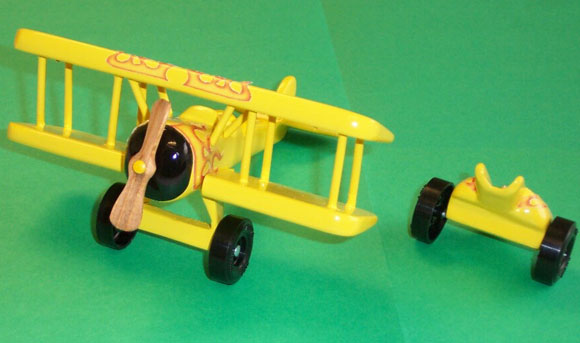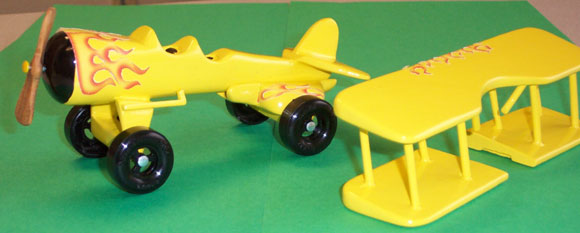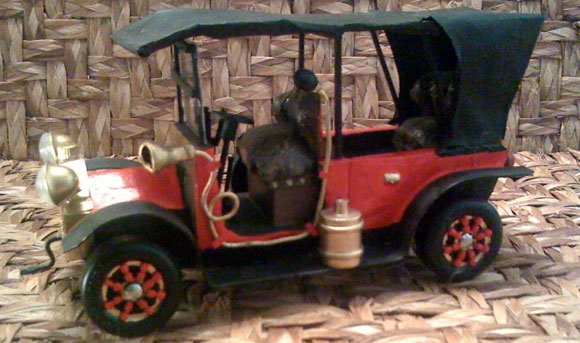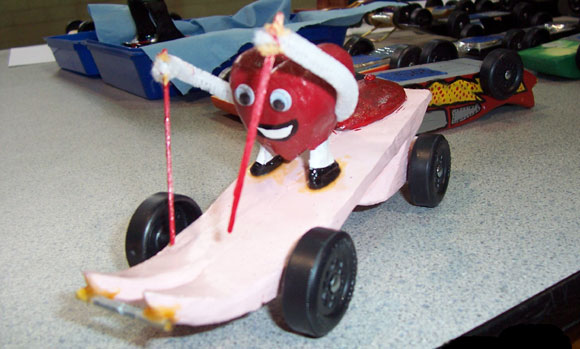– Feature Article – Top Fuel Cars: My CO2 Car
– Pinewood Derby Car Showcase
– Memory – The Trophy with the Blue and Gold Flames
– Q&A
Top Fuel Cars: My CO2 Car
(The seventh in a series of articles on cars that “stretch the rules”.)
In Volume 8, Issue 13 (March 18, 2009), a CO2 car developed by Rich Cagle was showcased. Rick’s car used a “trailer” to contain the firing mechanism. At the end of that article, I mentioned that a self- contained CO2 car of my invention had been completed. In today’s article I will describe that car, explaining some of the pitfalls, design considerations, and other lessons learned.
Background
As a quick review, CO2 cartridges contain pressurized carbon dioxide. When the end of the cartridge is punctured, the gas is released at high velocity, resulting in considerable thrust. Typically, these cartridges are used on cars that are run along a string in a parking lot. A starting mechanism is used to puncture the cartridge to initiate the run. To adapt this technology for use on a pinewood derby track, a mechanism must be developed which will puncture the cartridge when the starting pin drops.
My design goal was to build a car that was fully self-contained (no trailer vehicle). In addition to Rich’s car, I used two other designs I found on the Internet as inspiration:
Lance Allen’s Car
A self-contained car built by Lance Allen. As seen in the photos below, when armed, the rear of the car is lifted off the ground. I chose not to use this method of “cocking” the trigger as I did not want to risk any track damage. But I did borrow the spring and firing hammer design from this car.
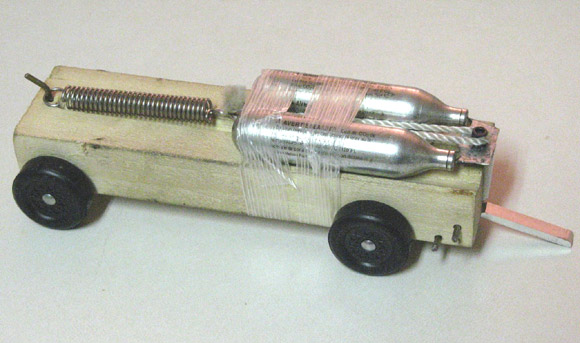
Photo from crazyallenmoments.blogspot.com/2008/10/lances-co2-pinewood- derby.html
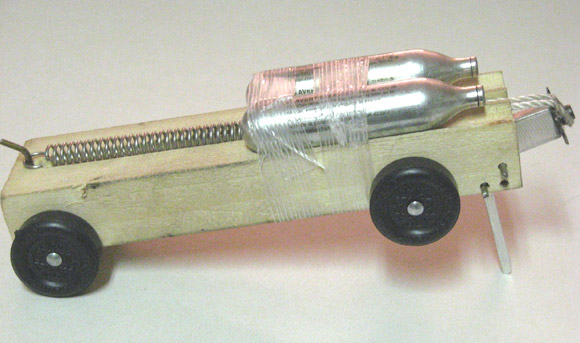
Photo from crazyallenmoments.blogspot.com/2008/10/lances-co2-pinewood- derby.html
Jeffrey Rein’s Car
Another self-contained car build by Jeffrey Rein. This car uses parts from a CO2 plane. My firing trigger is inspired by this car.
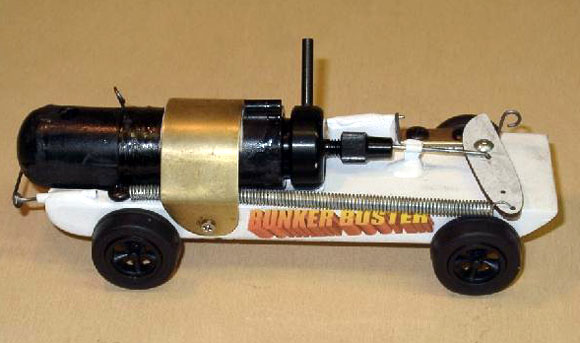
Photo from www.clcombat.info/jeffpinewood.html
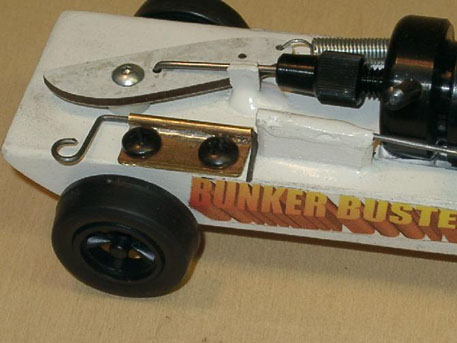
Photo from www.clcombat.info/jeffpinewood.html
First Prototype
Photos 5 through 7 show my first prototype of a self-contained CO2 car.1 All of the parts came from the local Ace Hardware,and a local hobby shop.
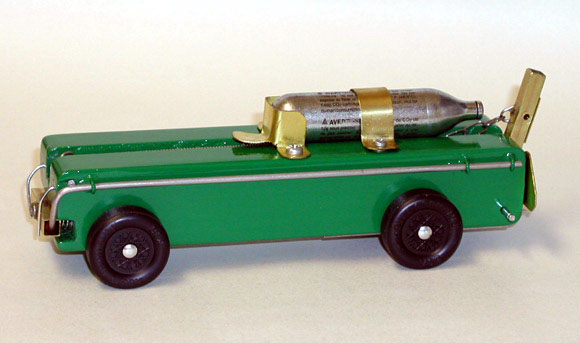
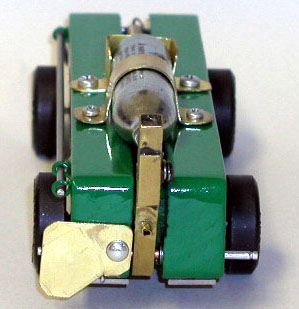
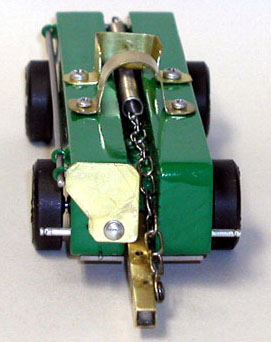
The basics of the firing mechanism on the prototype are as follows:
- Hammer is attached to a spring via a short chain.
- When armed, the brass plate holds the hammer in place, and is itself held by a steel rod on the left side of the car. When the steel rod is pulled forward, the brass plate is rotated by the hammer. Note the small pin at the bottom of the car that stops the rotation of the plate (keeps the plate from dragging on the track).
- The steel rod is pulled forward via two springs in the front of the car, behind the front “bumper”.
- The bumper is held back by the track starting pin. The two curved wires at the front of the car keep the bumper in place. What is not seen is a short steel rod extending back from the bumper, which slides in a tube under the car. This allows the bumper to move smoothly back and forth.
First Results
How did it work? After much tuning (adjusting spring tension, car weight, firing pin diameter, etc.), the car did function. It easily outran a standard pinewood derby car, but the performance was much less than anticipated. This lack of performance was because the firing mechanism required that the car be fairly heavy (9.5 ounces), so the single cartridge did not generate enough force to overcome the weight and give the breath-taking speed that you would expect from a CO2 car.2 Nevertheless I ran it a few times, and then the hammer bent and the firing pin broke. So, I went back to the drawing board.
Lessons Learned
I had not anticipated the number of design considerations that had to be taken into account when building a CO2 car. These considerations included:
- Hammer Spring
- Strong enough to allow the hammer to puncture the cartridge. However, a strong hammer spring requires a stronger front spring, which requires a heavier car, which requires greater thrust (a “Catch 22” situation).
- The Hammer Spring tension must relax just prior to puncturing the cartridge, so that the CO2 gas can push the hammer back out of the way (otherwise the firing pin plugs the newly formed hole).
- Front Spring
- Strong enough to pull the side rod to release the hammer.
- Must be adjusted to be held back by the weight of the car, which must be low as possible.
- Hammer
- Strong material – I used brass square tubing on the first design, but it eventually bent.
- High mass – The hammer must be heavy enough to puncture the cylinders (too light and it bounces off). On the prototype, I filled the brass hammer with tungsten disks to increase the mass.
- Firing Pin
- Proper Diameter – The hole in the CO2 must be of the optimum size so that the gas is fully released just as the car crosses the finish line. If it is too small, the cartridge still has gas remaining after the finish line. If it is too large, all of the gas is released at once, which blasts the car off of the track (quite comical, but pretty rough on the car). I found that the sharp end of a large straight pin works well.
- Strong and sharp – The pin must not bend easily, and must be very sharp.
- CO2 Cartridges
- I started with 8 gram cartridges (used on CO2 dragsters), but quickly progressed to 12 gram cartridges (for airsoft guns) – heavier but longer thrust.
Second Time’s The Charm
For the second pass (as seen in Photos 8 through 10), I went with a two cartridge design and a steel, T-shaped hammer.
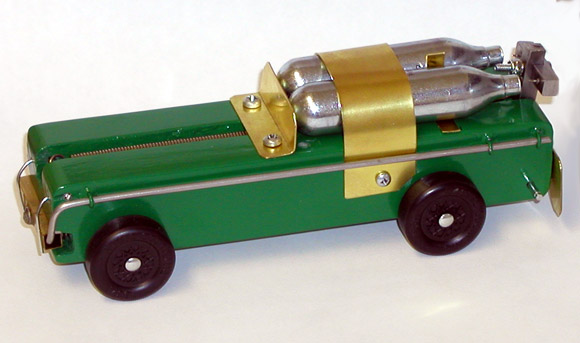
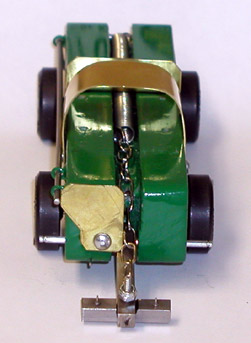
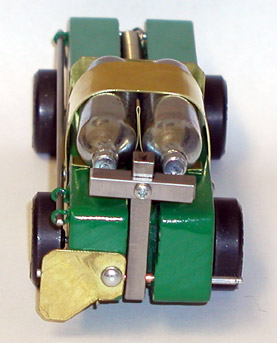
The firing mechanism is the same as the on the prototype. The weight of the car increased to 10 ounces, but the thrust was doubled, so the performance was satisfactory.
Here is a Quick Time Video of the CO2 car racing against a typical pinewood derby car.
Conclusion
Although this project consumed a lot more time than I had originally anticipated, it was a very satisfying experience. I enjoy tinkering, and this project required a lot of it! If you enjoy building projects and solving problems, then a CO2 car may be just the project for you. If you do build one, please send me photos and a description.
1Not mentioned in the article is the modular design of the car. All of the firing mechanism parts are held in place by removable pins. This allows the springs, chain, etc. to be quickly changed out without removing screws. Screws were only used to attach the CO2 cartridge bracket.
2This is the big advantage of Jeff Cagle’s trailer design. All of the excess mass can be put into the trailer, which allows the actual car to be relatively light weight. This allows a single cartridge to provide excellent performance.
Pinewood Derby Car Showcase
Bi-Plane: Doug Kile
Last year I sent in a picture a picture of my John Deere Tractor. This Bi-Plane is what I made for this year. It legal to run with the wings removed.
Model T: Gary Trousdale
My son’s pack has a siblings and parents category, so I decided to enter. As far as what design I would use, I had about 100 ideas flying around in my head. The Model T came about mostly because I knew no one else would do it, and I’m fairly sure I’ve never seen one before.
I downloaded a lot of pictures of old Model T cars and trucks and settled on the touring car design. The body is still the original wood block from the BSA kit, just cut up and re-arranged a bit. The running boards are brass strips from a hobby store, likewise the grill, mounted in foam core. The headlights, taillights and compression tank were from a jewelry and craft store. The brass front bumper had to come off due to weight. The canopy is paper, measured, cut, folded and painted over a wooden frame (again, the metal was too heavy). The seats are foam rubber with lacquered and painted tissue paper seat covers. The gear shift levers, horn, and windshield were fabricated pretty much from wire, Sculpey, sheet styrene and paint.
The car ran pretty slow, despite my grinding and polishing the axles. I don’t think it was a question of air resistance as much as the wheels themselves were out of balance — I put hub spokes made of painted toothpicks on them. Oh well, it looked really cool.
Valentine C-A-R: Galen Jordan
This car was made as a Valentine C-A-R (not card) for my wife since our race was on February 14. we originally did not intend to race it. but, we caved to peer pressure and let my daughter race it in the 11 and under open class without any preparation other than graphite. It took second place. It was a great day of racing for the whole family.
Pinewood Derby Memory
The Trophy with the Blue and Gold Flames
The trophy was three feet tall with four columns made of royal blue and gold flames. There were derby cars at every point, and the base was a dark cherry wood. I had never seen anything that shimmered so much — the flames seemed to flicker in the light. I turned away from the trophy and looked for my son through the crowd of boys standing around the practice track. I wondered if I should show him the trophy? Would he have a chance of winning it? Looking at the impressive six lane aluminum track, with computerized timer and large screen display up on the wall, I definitely felt that we were out of our league. My son had never raced on anything but old wooden tracks. His car had never actually been timed. When we first arrived at the venue, I spotted this nice, three lane aluminum track. I had even complimented the man in uniform standing next to it. “What a nice track”, I had said. He turned to me with a sort of puzzled look on his face. Five minutes later, I realized why he had given me the puzzled looked. I walked further into the venue and saw the six lane behemoth. The three lane track in the foyer was just the practice track that they had set up for the boys to have a few runs on. The six lane track was the real deal! “Wow!” I thought, “we are in the big league now.”
When Ethan was invited to attend this Open District pinewood derby I had been advised (warned?) that there would be tough competition. I remembered the first year at our pack’s pinewood derby and the thrill when my son’s car won its first heat. Then the agony when it lost every other race. I had gone home that night determined to learn everything possible about the pinewood derby so that I could help Ethan build a better car the next year. When the derby rolled around again, I had stayed true to my word. We built a great car. He won the district championship. But, the experience was not a thrill for him, as I had taken over much of the building of the car. In my efforts to spare him the embarrassment of a bad car, I had cut him out of much of the work and fun. This year, I promised him that I would act as an advisor only. It would be his car to build.
Build it, he did. Every time I hovered, Ethan would remind me to back off. With the exception of adjusting one slightly crooked wheel after he had gone to bed (could not help myself), it was all his car, and he was proud of it. Still, I stood looking up at the shiny track at this open derby, wondering just how good his car would be. What would I say if my son went home empty handed? Defeat is a part of competition, and I knew that Ethan would handle losing much better then I would. But I wanted him to do well. Our family was is the midst a very traumatic year, starting with my daughter nearly being killed in a horrific accident the previous January. Her recovery has been long and difficult. Often, Ethan had been shoved into the background while my husband and I struggled through surgeries, hospital stays, doctor visits and a ton of medical bills. Throughout the ordeal, Ethan had endured it all with a stoicism not found in many 10 year olds. Building the derby car was one of the few lights in a very dark and stressful year. The pinewood derby race had been a small source of pleasure in a bleak existence for our family. Now I worried that the thrill of Ethan’s beloved derby car would be diminished by a thrashing at this open derby. I was very worried.
The races began with the Tiger scouts. Their cars shot down the track at lightening speeds and after just a couple of heats the large screen on the wall flashed: “New Track Record!” “Oh boy”, I thought. “We are in trouble!” I tried to have confidence in Ethan’s car (it was a fast car), but I secretly worried that I had made a mistake by bringing him to this race. The track record was broken twice more in the Tiger heats and two times in the Wolf heats. Ethan’s car had won overall in our pack, but it is not a large or competitive pack when it comes to the pinewood derby. Ethan’s car was used to bumping along on the 30+ year old, 32 foot long track. How would it do on this huge shiny aluminum track? Would it even make it all the way down the 42 feet of aluminum? I squirmed a little in my chair as the Bears were finishing their heats and it was almost time for Ethan to race.
Every boy got to race in every lane and there were more Webelos then lanes, so several boys sat out the first heat. Ethan did not race until the third heat. In the first two heats I had picked out a couple of cars that were very fast, but there had been no more track records, so my hopes increased a bit. Still, as Ethan stepped up to place his car in Lane #1 for his first race, I found myself chewing on my nails! I was gnawing away with anxiety and my heartbeat must have doubled. My mom looked over at me and asked, “Are you ok, you look pale?” I gave a quick nod, “Yes”, but I did not feel ok. The anxiety was choking me, and all that I could manage was a little silent prayer: “Please let this be ok, please don’t let Ethan be too disappointed — he’s a good kid.” I know that the other boys had worked just as hard on their cars as Ethan had, and he did not deserve to win anymore then any other boy. I just wanted him to do well for his own self esteem. This was HIS day (a day that centered around him) instead of around his sister and the next surgery. Instead of the family sitting in a hospital waiting room, we had all gathered to support Ethan and cheer him on in a fun activity. Please, Dear God let this be a fun activity! I looked over at my aunt and my husband; she gave me a thumbs up, and my husband said, “Here we go.” His voice choked a little; he was nervous, too! I turned back just in time to see the pins go down and the cars burst onto the track!
Ethan’s car was like a bullet! It shot forward, leading the pack by at least two lengths on the down slope. By the time that they got to the flat section a slick black car was gaining ground, but was still trailing by almost a length. Ethan’s car flew through the finish line in a solid first place! A shudder of relief surged through my body! I felt limp with relief. Ethan’s car may not win the day, but at least I knew that we would not go home in total embarrassment. This open derby was not out of our league and I was so thankful!
Ethan’s car raced another five times. After its third heat, the screen flashed: “New Track Record!” Ethan’s car had set a new track record! I was so happy that I was bobbing up and down in my chair. My nephew was asking my husband what that meant, and Jesse replied, “It means that Ethan has the fastest car here!” Ethan’s car continued to win, beating every other Webelo car until that round of racing was over.
In between the rank races and the championship round, the boys were allowed to apply more graphite. I asked Ethan if he needed help, and he assured me that he could do it by himself. I watched him skip over to the pit area and join the other boys in prepping for the last round of races. He looked so happy. The top three boys from each rank would race for the championship awards. I knew that Ethan’s car would be meeting up with the best cars of the day, three of which had also set track records. The more that a car races the more the graphite gets worked in, so I knew that those Tiger and Wolf cars that had been fast earlier in the day would probably be even faster now. Ethan was currently holding the track record, but that could change.
Once again, Ethan did not race in the first couple of heats. My anxiety, which had pretty much gone away when his car was running so well in the Webelos race, came back with a vengeance! I squirmed, I chewed my nails, I gritted my teeth, waiting for Ethan to put his car on that track. One of the Wolf cars was a beautiful, slim red car with glitter in the paint. It had set the track record before Ethan and I knew that it would be a challenger for the grand prize. It had already raced one heat and had dominated. Now, it was time for Ethan’s car to race against the red demon.
Ethan’s car, which is green, was placed in the lane next to the red glitter car. My heart beat picked up speed and I almost couldn’t look at the track. Then, the race was on and the cars were close. The red car was staying up with Ethan’s car, but it had not pulled ahead. In the flat of the track, Ethan’s car scooted out to about a one-fourth of a length in front of the red car and that is the way that the race finished. It was the closest race of the day, and yet Ethan’s car had prevailed. I was in total joy! I knew that had been the toughest test. I relaxed a bit and enjoyed the rest of the races, with no car coming closer then a half of a length from Ethan’s car. The big screened flashed again, “New Track Record!” Ethan would set one more track record before the racing was finished that day. I chided myself for thinking that his car may not have been good enough to be in this race. I should have had more faith in both boy and car.
It was time for the awards ceremony. Ethan won a nice trophy for first place in the Webelos division. They gave out the awards for design and best paint. Then, it was time to announce the top three for the whole race. When Ethan’s name was called he was playing with another boy under the stage. I had to shoo him out to accept his trophy. His race statistics flashed on the big screen; his car went 241mph! Wow! The Cubmaster handed Ethan the huge trophy with the gold and blue flames, and remarked that it was almost as tall as Ethan. We all beamed with admiration, soaking in the joy of the moment. Ethan smiled at the trophy, walked over, handed it to his dad and then ran off to crawl back under the stage with his new friend. Maybe the journey really was more important then the destination. In the big scheme of things shiny trophies are just a footnote. But for that moment the trophy symbolized more then just a fast car. It was a reminder that even in the hardest of times there can be joy. It was proof that when a family is strong and sticks together they can make it through the darkness into the light. The trophy with the blue and gold flames was a beautiful thing but the lessons we learned on the way to possessing it would endure long after the shimmer had faded.
Teresa Delcambre
Q&A
We just got back from our Pinewood Derby and we’re trying to figure out what happened. We ended up in fourth place in Webelos. In the first four heats the car easily beat the other cars, coming in first. Then something happened and we came in 4th and 5th for the rest of the heats. Any idea what might have happened?
Sorry to hear that the car lost speed. Usually when this happens it is because the car was damaged in some way. Possibly an axle got bent or moved, or a piece of debris got caught on the wheel. Racing can be a bit rough on the cars, especially if the people handling the cars are not careful, or the braking section is quite abrupt.
Were the heats timed? If so, then you can see if the car had a big increase in time for the final runs.
I have modified the location of the axles so that they are about 5/8 inch from the end of the car on either end. I have not reduced the length of the car. I got this idea from the Internet, but now it occurs to me that not everything from that source can be relied upon. Can you offer any last words of wisdom on this?
If allowed by the local rules, extending the wheelbase is generally good. We typically place the axles at 11/16 inch from the ends of the block. This insets the wheels a touch, which minimizes the risk of the front wheels colliding with the stopping system.
To get the most advantage of an extended wheelbase, you need to move the weight of the car back, so that you still achieve the desired balance point of about one inch in front of the rear axle.
I am a little confused about the center of gravity (COG). You say the best is between 3/4 and 1 inch from the back axle. I have been racing with a COG at approximately 3/4 inch from the back axle, and have been fairly successful with this alignment. If I could, would it make a faster car to move the COG as far back as possible to say 1/4 inch? We race with standard axle slots on a smooth track. I guess my question is how far back can or should you move the COG for the best performance. Is there such a thing as too far back? Does having the COG so far back put added friction on the back axles?
I recommend 3/4 to 1 inch as that will give a fast and stable ride on most tracks. However, the further back the balance point, the more potential performance you can get. But the further back you go, the greater the risk of instability.
At some point there will not be enough weight on the front axles to keep them pressed against the front wheel bores. Any little bump will cause the axles to lift slightly. When this happens the car loses control, which is generally seen as rapid zigzagging on the track. Typically this occurs somewhere around the middle of the flat section.
So, can you get more speed at 1/2 or 1/4 inch? The physics answer is yes, but the real life answer is that the risk of instability will greatly increase, leading to a bad run. Certainly, you must use rail-riding alignment if you go with this type of aggressive COG.
Want Answers?
Do you have a pinewood derby-related question? If so, e-mail us your question.We answer all questions by e-mail, but not every question will appear in the Q&A section of the newsletter.
Back Issues
Are you a new subscriber, or have you missed some of the previous newsletters? Don’t miss out; all of the issues for Volume 5 through Volume 17 are posted on our web site.
Newsletter Contributions
We welcome your contributions. If you would like to contribute an article, a web site review, a speed tip, or a pinewood derby memory, please e-mail us.
Subscription Information
The Pinewood Derby Times is a free e-newsletter focused on pinewood derby racing. It is published biweekly from October through March.
If you haven’t already done so, please forward this issue to your pinewood derby friends. But please don’t subscribe your friends. Let them decide for themselves. Thanks.
If this newsletter was forwarded to you, why not subscribe to receive this newsletter. There is no cost, and your e-mail address is safe, as we never sell or share our distribution list.
To subscribe, send a blank e-mail to
pi*********************@*******st.com
You will receive a confirmation e-mail. Reply to the confirmation e-mail and you will start receiving the Pinewood Derby Times with the next issue.
Randy Davis, Editor, Pinewood Derby Times
E-Mail: in**@**************ty.com
(C)2018, Maximum Velocity, Inc. All rights reserved. Please do not reprint or place this newsletter on your web site without explicit permission. However, if you like this newsletter we grant permission, and encourage you to e-mail it to a friend.
Maximum Velocity disclaims any personal loss or liability caused by utilization of any information presented in this newsletter.
The Pinewood Derby Times is not specific to, and is not affiliated with the Boy Scouts of America, YMCA, Awana, or any other organization.
(R)Maximum Velocity is a registered trademark of Maximum Velocity, Inc.
(R)Pinewood Derby is a registered trademarks of the Boys Scouts of America.
(R)Awana is a registered trademark of Awana Clubs International.
All other names are trademarks of their respective owners.

